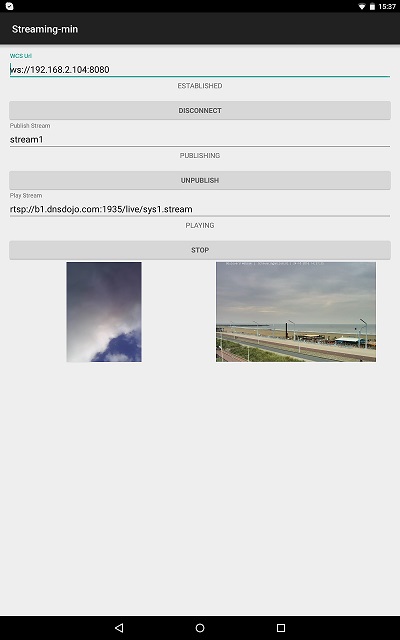Android Two-way Streaming¶
Example of Android application with player and streamer¶
This streamer can be used to publish WebRTC video stream and play any of the following types of streams on Web Call Server
- RTSP
- WebRTC
- RTMP
On the screenshot below the example is displayed when a stream is being published and another stream is being played.
Input fields
WCS URL, where192.168.2.104is the address of the WCS serverPublish Stream- for the name of published streamPlay Stream- for the name of played stream
Two videos are played
- left - video from the camera
- right - the played video stream

Analyzing the example code¶
To analyze the code, let's take class StreamingMinActivity.java of the streaming-min example, which can be downloaded with corresponding build 1.0.1.38.
1. Initialization of the API¶
Flashphoner.init() code
For initialization, Сontext object is passed to the init() method.
2. Session creation¶
Flashphoner.createSession() code
SessionOptions object with the following parameters is passed to createSession() method:
- URL of WCS server
SurfaceViewRenderer localRenderer, which will be used to display video from the cameraSurfaceViewRenderer remoteRenderer, which will be used to play video stream
sessionOptions = new SessionOptions(mWcsUrlView.getText().toString());
sessionOptions.setLocalRenderer(localRender);
sessionOptions.setRemoteRenderer(remoteRender);
/**
* Uncomment this code to use your own RTCConfiguration. For example, you can use custom TURN server
*/
//List<PeerConnection.IceServer> iceServers = new ArrayList<>();
//iceServers.add(new PeerConnection.IceServer("turn:your.turn-server.com:443?transport=tcp","username","passw0rd"));
//PeerConnection.RTCConfiguration customConfig = new PeerConnection.RTCConfiguration(iceServers);
//sessionOptions.setMediaOptions(customConfig);
/**
* Session for connection to WCS server is created with method createSession().
*/
session = Flashphoner.createSession(sessionOptions);
3. Connection to the server¶
Session.connect() code
4. Receiving the event confirming successful connection¶
Session.onConnected() code
@Override
public void onConnected(final Connection connection) {
runOnUiThread(new Runnable() {
@Override
public void run() {
mConnectButton.setText(R.string.action_disconnect);
mConnectButton.setTag(R.string.action_disconnect);
mConnectButton.setEnabled(true);
mConnectStatus.setText(connection.getStatus());
mPublishButton.setEnabled(true);
mPlayButton.setEnabled(true);
}
});
}
5. Permissions request to publish video stream on Publish button pressing¶
ActivityCompat.requestPermissions() code
mPublishButton.setOnClickListener(new OnClickListener() {
@Override
public void onClick(View view) {
if (mPublishButton.getTag() == null || Integer.valueOf(R.string.action_publish).equals(mPublishButton.getTag())) {
ActivityCompat.requestPermissions(StreamingMinActivity.this,
new String[]{Manifest.permission.RECORD_AUDIO, Manifest.permission.CAMERA},
PUBLISH_REQUEST_CODE);
...
} else {
...
}
...
}
});
6. Video streaming when permissions are granted¶
Session.createStream(), Stream.publish() code
case PUBLISH_REQUEST_CODE: {
if (grantResults.length == 0 ||
grantResults[0] != PackageManager.PERMISSION_GRANTED ||
grantResults[1] != PackageManager.PERMISSION_GRANTED) {
Log.i(TAG, "Permission has been denied by user");
} else {
mPublishButton.setEnabled(false);
/**
* The options for the stream to publish are set.
* The stream name is passed when StreamOptions object is created.
*/
StreamOptions streamOptions = new StreamOptions(mPublishStreamView.getText().toString());
/**
* Uncomment this code to use case WebRTC-as-RTMP. Stream will be republished to your rtmpUrl
*/
//streamOptions.setRtmpUrl("rtmp://192.168.1.100:1935/live2");
/**
* Stream is created with method Session.createStream().
*/
publishStream = session.createStream(streamOptions);
...
/**
* Method Stream.publish() is called to publish stream.
*/
publishStream.publish();
Log.i(TAG, "Permission has been granted by user");
}
}
7. Stream playback on Play button pressing¶
Session.createStream(), Stream.play() code
mPlayButton.setOnClickListener(new OnClickListener() {
@Override
public void onClick(View view) {
mPlayButton.setEnabled(false);
if (mPlayButton.getTag() == null || Integer.valueOf(R.string.action_play).equals(mPlayButton.getTag())) {
/**
* The options for the stream to play are set.
* The stream name is passed when StreamOptions object is created.
*/
StreamOptions streamOptions = new StreamOptions(mPlayStreamView.getText().toString());
/**
* Stream is created with method Session.createStream().
*/
playStream = session.createStream(streamOptions);
...
/**
* Method Stream.play() is called to start playback of the stream.
*/
playStream.play();
...
} else {
...
}
...
}
});
8. Stream playback stop on Stop button pressing¶
Stream.stop() code
9. Streaming stop on Unpublish button pressing¶
Stream.stop() code
10. Session disconnection.¶
Session.disconnect() code
mConnectButton.setEnabled(false);
/**
* Connection to WCS server is closed with method Session.disconnect().
*/
session.disconnect();
11. Receiving the event confirming successful disconnection¶
Session.onDisconnection() code
@Override
public void onDisconnection(final Connection connection) {
runOnUiThread(new Runnable() {
@Override
public void run() {
mConnectButton.setText(R.string.action_connect);
mConnectButton.setTag(R.string.action_connect);
mConnectButton.setEnabled(true);
mPublishButton.setText(R.string.action_publish);
mPublishButton.setTag(R.string.action_publish);
mPublishButton.setEnabled(false);
mPlayButton.setText(R.string.action_play);
mPlayButton.setTag(R.string.action_play);
mPlayButton.setEnabled(false);
mConnectStatus.setText(connection.getStatus());
mPublishStatus.setText("");
mPlayStatus.setText("");
}
});
}